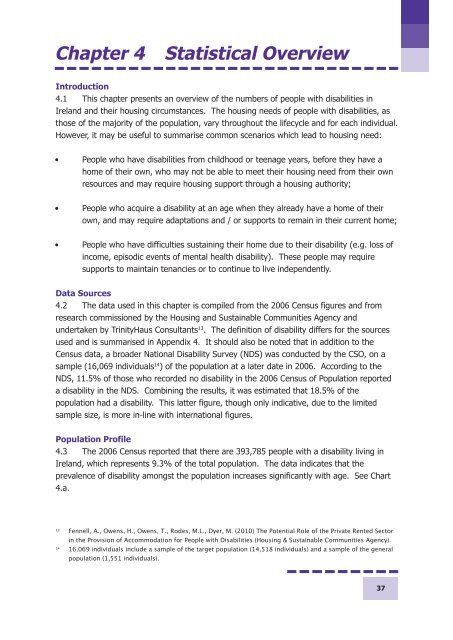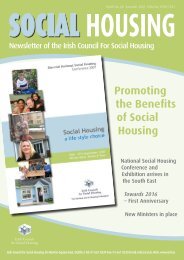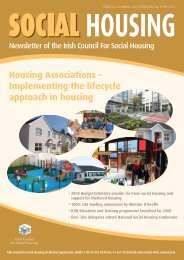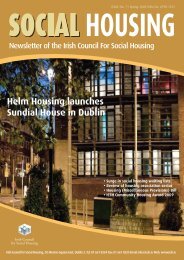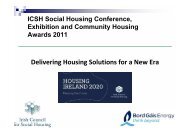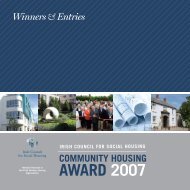National Housing Strategy for People with a Disability 2011 - 2016
National Housing Strategy for People with a Disability 2011 - 2016
National Housing Strategy for People with a Disability 2011 - 2016
Create successful ePaper yourself
Turn your PDF publications into a flip-book with our unique Google optimized e-Paper software.
Chapter 4Statistical OverviewIntroduction4.1 This chapter presents an overview of the numbers of people <strong>with</strong> disabilities inIreland and their housing circumstances. The housing needs of people <strong>with</strong> disabilities, asthose of the majority of the population, vary throughout the lifecycle and <strong>for</strong> each individual.However, it may be useful to summarise common scenarios which lead to housing need:• <strong>People</strong> who have disabilities from childhood or teenage years, be<strong>for</strong>e they have ahome of their own, who may not be able to meet their housing need from their ownresources and may require housing support through a housing authority;• <strong>People</strong> who acquire a disability at an age when they already have a home of theirown, and may require adaptations and / or supports to remain in their current home;• <strong>People</strong> who have difficulties sustaining their home due to their disability (e.g. loss ofincome, episodic events of mental health disability). These people may requiresupports to maintain tenancies or to continue to live independently.Data Sources4.2 The data used in this chapter is compiled from the 2006 Census figures and fromresearch commissioned by the <strong>Housing</strong> and Sustainable Communities Agency andundertaken by TrinityHaus Consultants 13 . The definition of disability differs <strong>for</strong> the sourcesused and is summarised in Appendix 4. It should also be noted that in addition to theCensus data, a broader <strong>National</strong> <strong>Disability</strong> Survey (NDS) was conducted by the CSO, on asample (16,069 individuals 14 ) of the population at a later date in 2006. According to theNDS, 11.5% of those who recorded no disability in the 2006 Census of Population reporteda disability in the NDS. Combining the results, it was estimated that 18.5% of thepopulation had a disability. This latter figure, though only indicative, due to the limitedsample size, is more in-line <strong>with</strong> international figures.Population Profile4.3 The 2006 Census reported that there are 393,785 people <strong>with</strong> a disability living inIreland, which represents 9.3% of the total population. The data indicates that theprevalence of disability amongst the population increases significantly <strong>with</strong> age. See Chart4.a.13Fennell, A., Owens, H., Owens, T., Rodes, M.L., Dyer, M. (2010) The Potential Role of the Private Rented Sectorin the Provision of Accommodation <strong>for</strong> <strong>People</strong> <strong>with</strong> Disabilities (<strong>Housing</strong> & Sustainable Communities Agency).1416,069 individuals include a sample of the target population (14,518 individuals) and a sample of the generalpopulation (1,551 individuals).37


